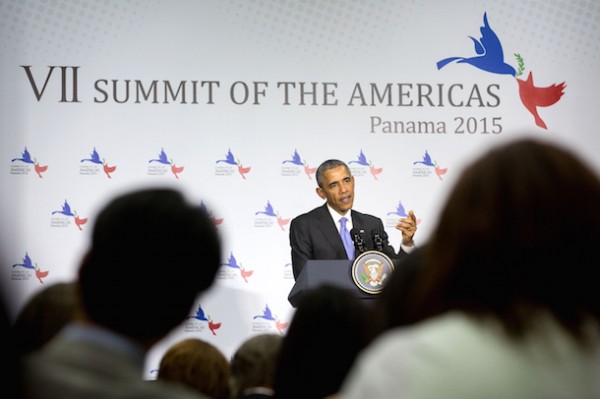
President Obama speaks during a press conference at the Summit of the Americas.
Photo Courtesy: Amanda Lucidon
In particular, U.S. relations with Central American nations seem promising as the U.S. stated in 2014 that it intended to fund social and economic projects in Guatemala, Honduras, and El Salvador through the “Alliance for Prosperity in the Northern Triangle” Program.
Recently announced as part of the 2016 U.S. Fiscal Budget, the “Alliance for Prosperity” Program exposes a renewed American interest in the region. In attempt to uplift current conditions in these three countries, which were the cause of a major security and immigration crisis for the U.S. last year, President Obama has continued to focus on the need for U.S. involvement in an effort to prevent future economic and security threats emanating from the region.
The program, which includes a $1 billion fund, primarily focuses on promoting human rights, assisting the 40,000 unaccompanied children that crossed into the U.S. in 2014, improving the work and business climate, and ensuring more effective governments.
While all of this sounds positive, the recent political and economic outreach in the region looks all too familiar. The U.S. is using the old-fashioned “Good Neighbor” policy to attract Central American leaders. The “Alliance for Prosperity” plan ultimately resembles more of a U.S. National Security Plan than a social and economic investment program benefiting Honduras, Guatemala and El Salvador.
A Déjà-Vu from the Banana Wars
U.S.-Latin American relations have always been complicated. Central America is no exception.
One of the largest criticisms levelled against historic U.S. policy in the region is the U.S.’s relentless interventionism and manipulation—the Banana Wars legacy has only served to bolster this view. Furthermore, it wasn’t too long ago that the U.S. backed a military coup against Honduras’s democratically elected President Manuel Zelaya in 2009.
As Hilary Clinton admitted the U.S. role in the Honduran coup in her recent book, scholars argue that the U.S. backed coup “opened the door for further violence and anarchy.” Still backing the new right wing regime in Honduras and providing military support in Guatemala, the recent U.S. political, economic and military interventions remind us of a similar time when the U.S. conducted damaging military interventions from 1898 to 1940 to pursue its own agenda.
Moreover, even though the Banana Wars ended decades ago, it seems as though its legacy and 1940 U.S. foreign policy still resonate in 2015, impeding economic and social growth in Central America. The Alliance for Prosperity program reflects U.S. determination to protect its commercial and security interests at the detriment of other nations, in particular Honduras, Guatemala and El Salvador.
With the long standing history of major corporations like United Fruit Company scheming against domestic economic growth in Central America, the Banana Wars legacy is still relevant today. The economies of the Alliance for Prosperity countries are primarily owned by the private sector.
The program may invite new investments in various sectors in Honduras and Guatemala, but it will be pouring money into and uplifting already successful corporates rather than incite innovation and domestic economic growth.
As Central America has been plagued by economic instability, entrenched corruption, and proliferation of drug trafficking and transnational criminal activities, political endorsement of right wing regimes and investment in particular economic sectors will only exacerbate the underlying problems of social and economic inequality.
Even though the Alliance for Prosperity attempts to address security and economic issues, it provides a new window of opportunity for large businesses, American owned corporations, and local elites to succeed in their respective countries by monopolizing upon the benefits of the $1 billion plan.
A way forward
If the Alliance for Prosperity Program and the Obama administration face reality in Central America, corruption, security issues and poverty could be properly dealt with through stricter implementation of the $1 billion plan. With real market opportunities within close proximity of the U.S., Honduras, Guatemala and El Salvador offer growing prospects for economic diversification and investments in untapped sectors.
Thus, the Alliance for Prosperity Program has the potential to spur investment and market opportunities for U.S. and international firms. Yet, even though human rights and democracy are core values of U.S. foreign policy, these concepts have been used as rhetorical tools for the U.S. to craft its own narrative in the region to suit its own political and economic agenda.
Unless the Obama administration and Central American political and economic influencers focus on driving economic and social growth in their countries, the program will become another disastrous U.S. intervention in the region, exacerbating underlying problems of corruption, economic decline and social inequality.
By Alicia Chavy for Global Risk Insights – InternationalPolicyDigest.org
You must be logged in to post a comment Login